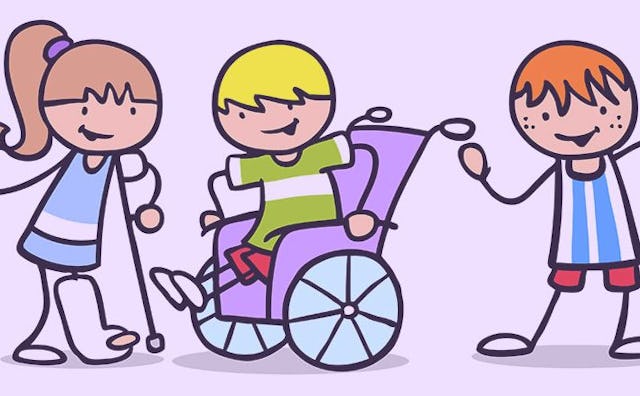Why I Don't Fear For My Disabled Son

I’m from the generation of children who avoided kids who walked funny.
Yes, it’s true. We also avoided kids who breathed loudly, who wore back or leg braces (teeth braces were somehow okay) or who had seizures at school. We avoided the kids who spoke with slurred speech and who rode in wheelchairs. We avoided the ones who had to leave the room every day for an hour with the special education teacher.
I am ashamed.
It’s not like I ever outright teased anyone. I just acted like they were invisible.
I remember the girl with scoliosis and bone deformities who breathed heavily every time she spoke. I always felt a prickly sensation whenever I heard her slow and effortful voice in class. Was I annoyed at how slow she was talking? Was I mad that my poor ears were subjected to these sounds? Probably, because I didn’t know any better.
I wasn’t a bad kid. I wasn’t a mean kid. It was a very different time, and disabilities just weren’t addressed in the same way they are now.
The girl with scoliosis had a spine that curved in a way that her lungs were small, and that’s why speaking took such effort. But that was never discussed. There was no understanding of the fact that every step she took was the result of intensive physiotherapy, after her parents were told she might never walk. We didn’t know that each of those strange steps was a miracle. It was the 1980s, after all.
Back in seventh grade, a boy in my class had a seizure on the playground. We all watched from the window in silence. The teachers called 911, and I remember how they wrapped him in a big gray blanket while waiting for the ambulance. He came to school the next day. He looked okay to me, so I never asked him how he was. Let me repeat that: He looked okay to me, so I never asked him how he was.
I can’t imagine what it took, emotionally or physically, for him to get out of bed, out of the house, into the car, out of the car, and into the classroom to face the 25 students who watched him convulse on the playground the previous day.
We went on with our lives, and they went on with theirs. Remember: I wasn’t mean, but I wasn’t nice.
I have been trying to come to terms with the child I once was, back in the 1980s, in contrast to the person I’ve slowly morphed into after becoming a mother. Not just any mother, of course, but a mom to a boy with a rare genetic disease.
© Courtesy Jennifer Philip-Zakic
My son has chronic lung disease due to deformities in his ribcage and chest wall. His bones don’t grow the way they’re supposed to. He just started taking some unassisted steps, but he has a shaky, drunken sailor gait, exacerbated by the leg braces he’s had to wear for the past three years. He has trouble breathing, and has worn oxygen for the past 17 months. He uses a hot and noisy machine to help him breathe at night. Sometimes he speaks very slowly. Sometimes he can’t beckon enough air to speak at all.
Oh my, the irony. (Or is this Alanis Morrissette’s version of irony? In other words, just another old-fashioned case of bad luck?)
It’s not like I can change the past.
I was, after all, just a child, so I can’t possibly be blamed for my ignorance. I would never be able to point a finger at something specific to blame for my fear, but instead a broad wave of my hand in the general direction of the culture at the time. For the most part, adults aggressively shushed us whenever real questions were asked, the questions that might evolve into actual honest-to-goodness conversations on disability. Curiosity, especially honest curiosity, wasn’t exactly embraced in children the way it is now. Our past cultural ideas on disability were generally negative—it was something to fear, something that happened “to” a family.
The thing is, given my past experience, I should be incredibly fearful for my son’s future social life. Will he sit all alone on the bus? Will he be the one everyone ignores in gym class?
Oddly enough, I think everything might just be okay.
The most glaring difference between now and then is the wonderful creation of the Internet, a place that has given a stronger voice to people with disabilities. At any given time, in the year 2015, I can read blogs about parenting alongside a Down syndrome, spina bifida, cystic fibrosis, or mental health diagnosis. I can even read up on multiple perspectives—from healthcare practitioners, parents, teachers and even patients themselves.
We now live in a world where kindness is not only the norm, but rather, being unkind is within reach of becoming socially unacceptable. We live in a world where we are watched more closely, where behavior such as flipping the bird at a passing car or being rude on the subway might end up on a Tumblr somewhere. This new world, so drastically different from the one I grew up in, is providing the foundation for kindness. It’s up to us, the parents, to take full advantage of this opportunity.
Remind your children to ask their sick classmates how they are doing. Teach your kids that even stepping foot—or wheel—inside a school is nothing short of a miracle for those who walk, talk or behave differently. Teach your kids that there are questions to be asked about these differences. Guide them as to what those questions might be.
Gently steer them toward our new era of kindness, far away from that place in the 1980s where I spent my childhood.
This article was originally published on